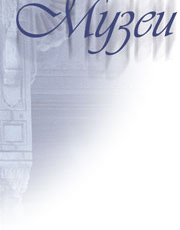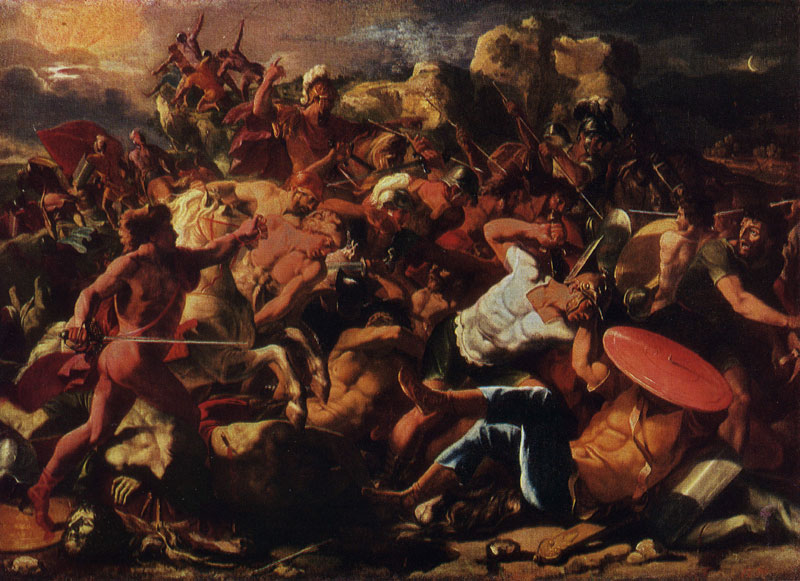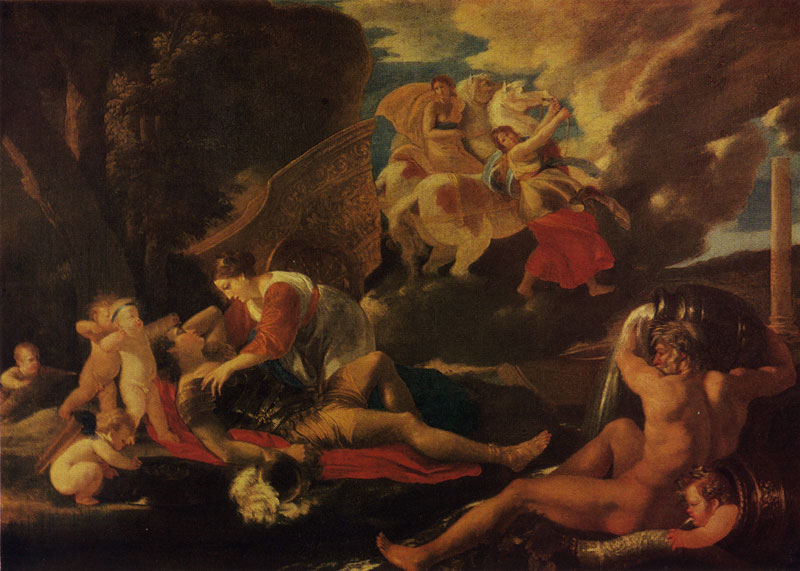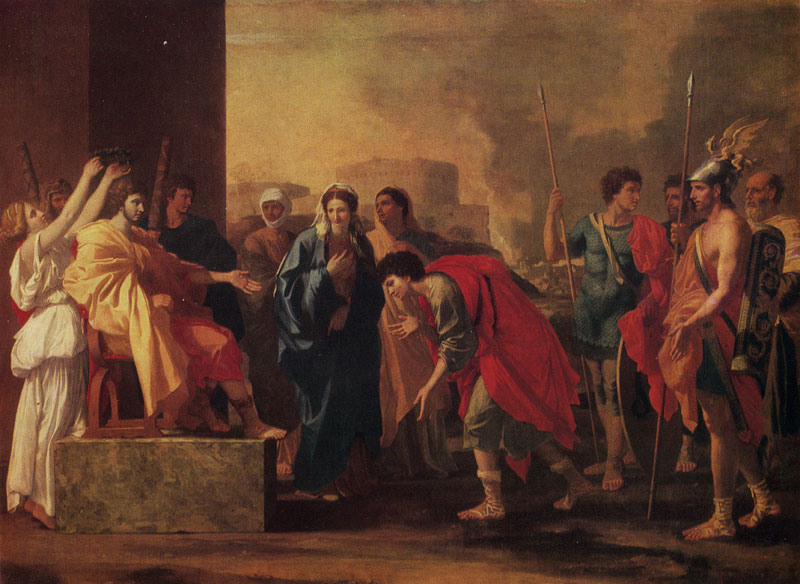
NICOLAS POUSSIN. 1594-1665
2 THE VICTORY OF JOSHUA OVER THE AMORITES
Oil on canvas. 96 X 130 cm. Inv. No 1046 This picture is a pendant to The Victory of Joshua over the Amalekites (The Hermitage, Inv. No 1395). The subject is taken from the Bible (Joshua, 10). This is one of Poussin's earliest known canvases. According to G. Bellori and A. Felibien, it was painted in 1625 or 1626, i.e. after the artist's arrival in Rome. The composition shows the influence of the School of Fontainebleau as well as of antique bas-reliefs and certain works of Giulio Romano, which Poussin could have seen in Italy. A preliminary drawing for the picture is in the Fitzwilliam Museum, Cambridge; another drawing is in the Albertina, Vienna. Provenance: 1770s—1927 The Hermitage, St Petersburg — Leningrad; since 1927 The Pushkin Museum of Fine Arts, Moscow
Exhibitions: 1955 Moscow, Cat., p. 57; 1956 Leningrad, Cat., p. 48; 1960 Paris, Cat. 3; 1978 Dusseldorf, Cat. O
Bibliography: KaT. TMHH 1948, p. 63; KaT. FMHH 1957, p. 113; KaT. FMHH 1961, p. 151; G. Bellori, Le Vite del pittori, scultori ed architetti moderni, Rome, 1672, p. 411';- Florent Le Comte, Cabinet de? singularites d'architecture, peinture et sculpture, 2nd ed., vol. 3, Paris, 1702, p. 24; F. Baldinucci, Dalle Noti-zie dei professori del dissgno, vol. 16, Florence, 1767—74, p. 99; Cat. Ermitage 1774, No 908; Notice sur PErmitage 1828, p. 70; Smith 1837, No 36; Cat. Ermitage 1863, No 1396; Waagen 1864, p. 282; COMOB 1900, No 1395; Friedlaender 1914, pp. 23, 112; Grau-toff 1914, vol. I, p. 65; ibid., vol. II, No 5; Magne 1914, p. 205, No 139; KaT. SpMHTaaa 1916, No 1396; Ernst 1928, p. 164; Reau 1929, No 277; L. Hourticq, La jeunesse dv Poussin, Paris, 1937, p. 153; S.-Ch. Emmerling, Antikenanwendung uni Antikenstudium bei Nicolas Poussin, Wurzburg, 1939, pp. 27, 76, ill.; F. Licht, Die Entwicklung der Landschaft in den Werken von Nicolas Poussin, Basle — Stuttgart, 1954; Sterling 1957, p. 29; A. Blunt, La Premiere periode romaine de Poussin, in: Actes du Colloque Poussin, vol. 1, Paris, I960, pp. 166, 168, 169, 171, 174; A. Blunt, Ch. Sterling, Exposition Nicolas Poussin, Paris, 1960, p. 42, No 3; F. Parisot, Les Natures mortes chez Poussin, in: Actes du Colloque Poussin, vol. 1, Paris, 1960, p. 217; J. Thuillier, Premiers compagnons francais de Poussin a Rome, in: Actes du Collogue Poussin, vol. 2, Paris, 1960, p. 75; FIpoKocpheB 1962, ill. 16; Musee de Moscou 1963, p. 134, ill.; Blunt 1967, p. 65, ill. 4; Thuillier 1974, No 12, ill.

2 THE VICTORY OF JOSHUA OVER THE AMORITES
3 RINALDO AND ARMIDA
Oil on canvas. 95 X 133 cm. Inv. No 2762 The subject is taken from Torquato Tasso's Jerusalem Delivered (XIV). O. Grautoff and A. Blunt date the picture to 1630—35, J. Thuillier to 1625—26, taking it to be one of Poussin's first works on a secular subject. A picture on a similar subject is known to have been executed by Poussin for his friend, the painter Jacques Stella. The Moscow painting is probably its replica. A later copy was in the Kaiser-Fried-rich-Museum in Berlin until 1914. Among the numerous variants on this theme the one now in the Dul-wich College Gallery (England) is best-known. The picture was etched with a needle by J. Sanders (1809) and by A. Reveil (1829).
Provenance: 1766—1930 The Hermitage, St Petersburg — Leningrad (acquired together with Poussin's Tancred and Erminia)', since 1930 The Pushkin Museum of Fine Arts, Moscow
Exhibitions: 1955 Moscow, Cat., p. 51; 1956 Leningrad, Cat., p. 49
Bibliography: Кат. ГМИИ 1948, p. 63; Кат. ГМИИ 1957, p. 113, ill.; Кат. ГМИИ 1961, p. 152, ill.; G. Bellori, Le Vite del pittori, scultori ed architetti mo-derni, 2nd ed., Rome, 1728, p. 191; Cat. Ermitage 1774, No 15; Labensky 1805, vol. 1, p. 27, ill.; C. Lan-don, Poussin, in: Vie et oeuvres des peintres les plus celebres. Ecole francaise, Paris, 1809, ill. 103; Notice sur 1'Ermitage 1828, pp. 67, 143; Smith 1837, No 287; Dussieux 1856, p. 441; Cat. Ermitage 1863, No 1407; Waagen 1864, p. 284; Сомов 1900, No 1407; Бенуа 1912, p. 170; Friedlaender 1914, pp. 51, 115; Grautoff 1914, vol. I, p. 109; ibid., vol. II, No 40; Magne 1914, p. 218, No 330; Кат. Эрмитажа 1916, No 1407; Reau 1929, No 291; L. Hourticq, La Jeu-nesse de Poussin, Paris, 1937, pp. 92—95, 174, 175; R. Lee, "Ut Pictures Poesis. The Humanist Theory of Painting", The Art Bulletin, 22, 1940, ill.; Вольская 1946, pp. 45—47, 155—156, ill.; P. Jamot, Con-naissance de Poussin, Paris, 1948, pp. 38, 72; Sterling 1957, ill. 16, p. 31; D. Mahon, Poussin au car-re/our des annees trente, in: Actes du Collogue Poussin, vol. 1, Paris, 1960, p. 262; F. Parisot, Les Natures mortes chez Poussin, in: Actes du Colloque Poussin, vol. 1, Paris, 1960, p. 219; Прокофьев 1962, ill. 18; ГМИИ 1966, No 53; Blunt 1967, p. 148, ill. 85; Charmet 1970, pp. 18, 19, ill.; Thuillier 1974, No 10, ill.; Antonova 1977, No 59

3 RINALDO AND ARMIDA
4 THE MAGNANIMITY OF SCIPIO
Oil on canvas. 114.5 X 163.5 cm. Inv. No 1048 The subject is taken from Livy's work Ab urbe con-dita (XXVI : 50). The picture was painted in the 1640s after Poussin's return to Rome. A copy by J. Smibert, executed in the early 1720s, is in the Bowdoin College Museum in Brunswick (USA). A preliminary drawing for the picture is in the Musee Conde at Chantilly (No 185 bis).
Provenance: in the early 18th century The Collection of J.-B. de Morville, France; 1722—45 The R. Wai-pole Collection, Houghton Hall, England; 1779—1927 The Hermitage, St Petersburg — Leningrad (purchased from the heirs of R. Walpole); since 1927 The Pushkin Museum of Fine Arts, Moscow
Exhibitions: 1955 Moscow, Cat., p. 52,; 1956 Leningrad, Cat., p. 48
Bibliography: Кат. ГМИИ 1957, p. 113; Кат. ГМИИ 1961, p. 152; H. Walpole, Aedes Walpolianae or a Description of the Collection of Pictures at Houghton Hall in Norfolk, 3rd ed., London, 1767, p. 89; La-bensky 1805, vol. 1, p. 115, ill.; C. Landon, Poussin, in: Vie et ceuvres des peintres les plus celebres. Ecole francaise, Paris, 1809, ill. 143; Notice sur I'Ermitage 1828, pp. 68, 143; Smith 1837, No 171;
A. Andresen, Nicolas Poussin. Verzeichnis der nach seinen Gemalden gefertigten Kupferstiche. . . , Leipzig, 1863, No 320; Cat. Ermitage 1863, No 1406; Waa-gen 1864, p. 285; Сомов 1900, No 1406; Friedlaender 1914, pp. 80, 117; Grautoff 1914, vol. I, pp. 222—223, No 107; Magne 1914, p. 199, No 43; Кат. Эрмитажа 1916, No 1406; Reau 1929, No 617; Вольская 1946, pp. 115, 117,156, iII.; Прокофьев 1962, iII. 22; Thuil-lier 1974, No 135, ill.; Antonova 1977, No 60

4 THE MAGNANIMITY OF SCIPIO
5 LANDSCAPE WITH HERCULES AND CACUS
Oil on canvas. 156 X 202 cm. Inv. No 2763 The subject is taken from Virgil's Aeneid (VIII). The picture was considered to be a pendant to Landscape with Polyphemus (The Hermitage, Inv. No 1186), but judging by the manner of its execution, it belongs to a later period. A. Blunt and D. Mahon date it to 1659-61.
Provenance: until 1772 The Collection of L. de Brienne, Marquis de Conflan, Paris; 1772—1930 The Hermitage, St Petersburg — Leningrad (acquired together with Poussin's Landscape with Polyphemus); since 1930 The Pushkin Museum of Fine Arts, Moscow
Exhibitions: 1955 Moscow, Cat., p. 52; 1956 Leningrad, Cat., p. 49; 1960 Paris, Cat. 108
Bibliography: Кат. ГМИИ 1948, p. 63, ill.; Кат. ГМИИ 1957, p. 113; Кат. ГМИИ 1961, p. 152, ill.; Smith 1837, No 307; Dussieux 1856, p. 440; Cat. Ermitage 1863, No 1413; Waagen 1864, p. 288; M. Tourneux, Diderot et Catherine II, Paris, 1890, pp. 58, 428; Сомов 1900, No 1413; Бенуа 1912, p. 172; Friedlaen-der 1914, p. 252; Grautoff 1914, vol. I, p. 257; ibid., vol. II, No 136; Magne 1914, p. 217, No 306, ill.; Кат. Эрмитажа 1916, No 1413; Dimier 1926—27, vol. 1, p. 52, ill.; Reau 1929, No 283; M. Alpatov, "Poussin's Problem", The Art Bulletin, 17, 1935, p. 22; A. Blunt, "The Heroic and the Ideal Landscape in the Work of Nicolas Poussin", Journal of the Warburg and Courtauld Institute, 1944, p. 157, 167; Вольская 1946, p. 131, ill.; B. Dorival, "Expression litteraire et expression picturale du sentiment de la nature au XVIIе siecle francais", La Revue des Arts, 1953, 3, p. 51; F.Licht, Die Entmicklung der Landschaft in den Werken von Nicolas Poussin, Basle — Stuttgart, 1954, p. 153; Sterling 1957, ill. 20, p. 32; H. Bardon, Poussin et la litterature latins, in: Actes du Collogue Poussin, vol. 1, Paris, 1960, p. 130; A. Blunt, Ch. Sterling, Exposition Nicolas Poussin, Paris, 1960, p. 215, No. 108; D. Mahon, Reflexion sur les paysa-ges de Poussin, in: Art de France, 1961, pp. 126, 127; Прокофьев 1962, ill. 26; D. Mahon, "Poussiniana", Gazette des Beaux-Arts, 60, 1962, pp. 2, 116, 121; M. Alpatov, Poussins Landschaft mit Herkules und Cacus in Moskau, in: Walter Friedlaender zum 90. Geburtstag, Berlin, 1965, p. 9, ill.; D. Mahon, Plea for Poussin as a Painter, in: Walter Friedlaender zum 90. Geburtstag, Berlin, 1965, p. 141; ГМИИ 1966, No 55; Blunt 1967, pp. 320-321, ill. 241; Thuil-lier 1974, No 215, ill.; Antonova 1977, No 58

5 LANDSCAPE WITH HERCULES AND CACUS
|
ПОИСК:
|
© MUSEUMS.ARTYX.RU, 2001-2021
При использовании материалов сайта активная ссылка обязательна:
http://museums.artyx.ru/ 'Музеи мира'
При использовании материалов сайта активная ссылка обязательна:
http://museums.artyx.ru/ 'Музеи мира'